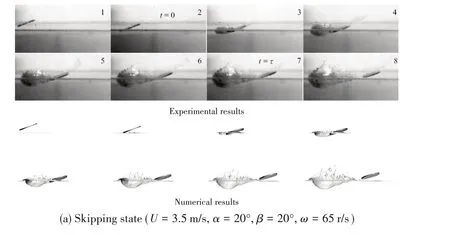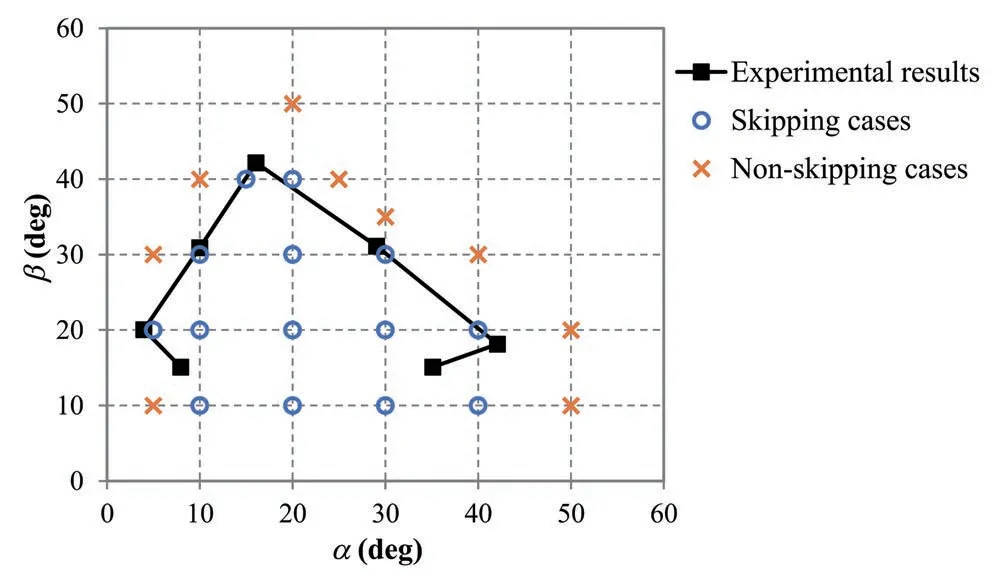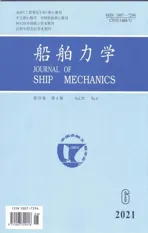Numerical Study on Kinetic Characteristics of Disk Skipping over Water Surface
2021-07-03,,
,,
(National Key Laboratory on Hydrodynamics,China Ship Scientific Research Center,Wuxi214082,China)
Abstract:The kinetic characteristics of a disk skipping over the water surface was studied in this paper based on the CFD method.Three typical impact states were simulated and the results were in good agreement with experimental results.The domain of successful skips with different initial parameters was obtained from numerical simulations.In the skipping process,a water jet forms ahead of the disk and the velocity of the jet separating from the disk could be twice as fast as the velocity of disk movement.With the increase of the spinning velocity,the hydrodynamic response of the water to the disk increases while the velocity attenuation of the disk also increases.The initial state with a relative small incidence angle and a tilt angle is always propitious to a successful skip,but a too small tilt angle may not be conducive to multiple skipping process.The simulation results of a complete disk skipping process indicate that the disk movement orientation is not straight forward but has a deflection in one direction affected by the spin.The height and distance of the first skip are much larger than those of the rest skips.
Key words:skipping;water impact;CFD;overset mesh
0 Introduction
Skipping is a kind of special motion happening when a body impacts on the water surface with a small angle.The skipping stone is a common example in which the stone needs to spin rapidly to maintain the attitude stability.In recent years,studies on high speed vehicles near the water surface have attracted more and more attentions.The vehicles may contact with water when flying close to the water surface and it is a key issue to keep the motion and attitude stable in the process of water impact.In this paper,the skipping motion of a flat disk is investigated based on CFD while the influence of different motion parameters on the skipping performance is analyzed,aiming to provide some referencesfor the study of trans-media vehiclesin the future.
Researches on the disk skipping over the water surface were carried out very early.Bocquet[1]systematically studied skipping stones in theory.He proposed a simplified description of the impact process of the stone with water and estimated the maximum number of bounces by considering both the slowing down of the stone and its angular stability.Clanet[2]carried out the skipping experiments of an aluminum disk and found that the lowest velocity for a successful bounce of the disk reaches a minimum when the angle between the disk and the water surface is about 20o.Rosellini[3]made a quantitative experimental study to extend Clanet’s results to several skips and proposed a simple model to discuss both the physical origin of the bounces and the source of the dissipation.In addition,there have been many relevant theoretical and experimental studies on the skipping of an object[4-8].Domestic studies mostly focused on the numerical simulations in which the methods used include the Arbitrarily Lagrange and Euler(ALE)method and the Smoothed Particle Hydrodynamics(SPH)method[9-11].However,these methods cannot capture flow details of the skipping process.Therefore,in this paper,the Computational Fluid Dynamics(CFD)method is used to simulate the process of a disk skipping over the water surface and analyze the influence of different parameters on the skipping motion.
1 Numerical method
The process of a disk skipping over the water surface is simulated by solving the Reynolds-Averaged Navier-Stokes equations for unsteady incompressible flow.For the multi-phase flow solutions,the Volume of Fluid(VOF)multiphase model is employed,which is good for solving problems involving free surfaces.It can model several immiscible fluids by solving a single set of momentum equations and tracking the volume fraction of each phase throughout the domain.The governing equations are written asfollows:



whereμt=Cμk2/εis the turbulence viscosity coefficient,C1,C1εandC2εare experience coefficients,σkandσεare the turbulent Prandtl numbers,PkandPεrepresent the generation of turbulence kinetic energy.
The 6-DOFsolver is used to deal with the motion of the disk by computing fluid forces and moments on a body.Pressure and shear forces are integrated over the surfaces of the 6-DOF body.The governing equation of the translating motion in the inertial coordinate system is

The governing equation of the rotating motion is constructed in the body local coordinate systemas

whereLis the tensor of the moments of inertia,Mis the resultant moment acting on the body,andΩis the angular velocity of the rigid body.
The finite volume method is adopted to discretize the governing equations,the segregated flow solver is used to solve the integral conservation equations of mass and momentum by employing a pressure-velocity coupling algorithm of SIMPLE,and the implicit time-stepping scheme is used for unsteady flows.
2 Computational model and grids
The calculation model is an aluminum disk with the radiusR=25 mm and the thicknessh=2.75 mm.The mass of the disk is 0.014 58 kg.The variable parameters in the calculation are the tilt angleα,the incidence angleβ,the translation velocityUand the spinning velocityω.The calculation model and the definition of parametersare presented in Fig.1.

Fig.1 Calculation model and definition of parameters
The grids were generated with the overlapping grid method which is useful in problems dealing with multiple or moving bodies.The overlapping grid method is usually used to discretize a computational domain with several different grids that overlap each other.In this paper,the computational domain has two regions:the background region enclosing the entire solution domain and the smaller overlap region containing the disk within the domain.The background region is stationary and cuboid with a dimension of 900 mm×400 mm×500 mm.The overlap region is movable and spherical with the dimension ofR=50 mm.Grids of computational domain and boundary conditions are shown in Fig.2.The face on the right side of the background region is set as the pressure outlet boundary while the other faces in the background region are set as the velocity inlet boundary.The volume fraction of air and water on the boundary is determined according to the position of the free surface.The surface of the disk is set as the wall boundary and the outside surfaces of the overlap region are set as the interface.The turbulent flow near the wall was computed with the non-equilibrium wall functions and the requirement of they+value is satisfied.The total number of gridsis about 1.6 million.

Fig.2 Grids of computational domain and boundary conditions
3 Results and discussions
3.1 Three typical impact states
According to the experimental results in the reference[3],there are three typical states when the disk impacts on the water surface:skipping,surfing and diving.The surfing regime can be seen as a critical state between the skipping state and the diving state.To verify the calculation method,these three typical cases were simulated and the differences of three states were analyzed.In Fig.3,the calculation results in this paper and the experimental results in the reference[3]were compared.It can been seen that the movement process of the disk,the cavity produced by impacting and the splash of the free surface are all in good agreement,which verified the accuracy of the numerical method in thispaper.
By comparing the impact process in Fig.3(a)and 3(b),it was found that under a certain velocity of translation and spin,different combinations of tilt angles and incidence angles could produce different motion states.For both the skipping state and the surfing state,the attack angle in the impact process almost remained the same.However,the splash in the surfing state was more violent,which means that the motion of the disk transferred more energy to the fluid.This is also the reason why the disk could not skip.The disk did not spin in the diving state as shown in Fig.3(c).It can be seen that the spinning velocity has great influence on the skip,because the tilt angle changes rapidly in the impact process without spin.


Fig.3 Comparison of the numerical results and the experimental results
3.2 Flow field of the skipping process
The variation of the flow field under the calculation condition thatU=3.5 m/s,α=20°,β=20°,ω=65 r/s is shown in Fig.4.Clanet[2]constructed the dynamical model of a disk skipping which assumed that the lift force on the plate was essentially proportional to its distance beneath the undisturbed water surface.Hewitt[7]found that the theoretical model did not consider the splashup region that formed ahead of the plate.From the calculation results of this paper,in the skipping process,there was indeed a water jet(marked with a red circle)forming ahead of the disk because of the compression of the liquid surface by the disk.The jet velocity of separation from the disk could be twice as fast as the disk translation velocity.It could also be seen that the disk had some rolling movement in the impact process as the disk was spinning with a high speed.At the same time,the splash of the water surface was not symmetric when viewed fromthe front direction.


Fig.4 Velocity field of the water surface in the skipping process
3.3 Parametersfor a successful skip
The reason for a successful skip is that there is enough energy for the disk to keep the motion speed and the incidence angle stable.The incidence angle isimportant for the distribution of the energy on the horizontal and vertical directions.In this chapter,the water impact process of the disk was calculated with the same translation velocity and spin velocity but in different combinations of tilt angles and incidence angles.A successful skip means that the lowest position on the disk should be higher than the water level again after an impact process.
The calculation results and the experimental results from Hewitt[7]were shown in Figs.5-6.It can be seen that there exists a maximum incidence angle of a successful skip under the condition of a certain tilt angle.At the tilt angle of 20°,the range of the incidence angle reached to the maximum.The maximum value of the incidence angle for a successful skip was between 40°and 50°,which was in good agreement with the results in the reference[3].The translation velocity was also a parameter to influence the impact process.The relationship between the incidence angle and the minimum velocity for skip under the condition ofβ=20°,ω=65 r/s was shown in Fig.6.It can be seen that the lowest velocity for a successful skip reached a minimum forα≅20°,which was also in good agreement with the experimental results.

Fig.5 Domain of the skipping cases in the{α,U min}plane withβ=20°,ω=65 r/s

Fig.6 Domain of the skipping cases in the{α,β}plane with U=3.5 m/s,ω=65 r/s
3.4 Influence of initial parameters
To make a more systematic and comprehensive analysis for the influence of the motion parameters,skipping processes were calculated under different spinning velocities,tilt angles and incidence angles,respectively.The vertical acceleration,the vertical position,the velocity attenuation and variation of tilt angle were compared for each of the initial motion parameters.The results were shown in Figs.7-9.
The comparisons of impact characteristics under different spinning velocities were presented in Fig.7.Other conditions remained the same asU=3.5 m/s,α=20°andβ=20°.It can be seen that with the increase of the spinning velocity,the maximum vertical acceleration increased,which led to the higher height of the disk centroid.As seen from Fig.7(b),the disk could not skip out of water with the spinning velocity of 15 r/s,which means that under the calculation conditions in Fig.7,there exists a critical spinning velocity for a successful skip.However,in view of velocity attenuation in Fig.7(c),a higher spinning velocity led to a larger velocity attenuation.The reason may be that the disk with a higher spinning velocity would drive the fluid around moving with a higher speed.It is believed that the stabilization of the tilt angle is the secret of skipping stones and it can be seen from Fig.7(d)that the larger the spinning velocity,the more stable the tilt angle is.

Fig.7 Comparison of collision characteristics under different spinning velocities
The comparison of impact characteristics under different tilt angles is presented in Fig.8.Other conditions remained the same asU=3.5 m/s,β=20°,ω=65 r/s.It can be seen that with the increase of the tilt angle,the maximal vertical acceleration decreased while the collision duration increased.The variation of the disk vertical position seems more complicated,which increased first and then decreased.The disk bounced with the biggest height atα=30°.Based on the results of velocity attenuation in Fig.8(c)and the variation of tilt angle in Fig.8(d),it can be concluded that a small tilt angle is advantageous to a stable skipping process,though the bounced height is not high atα=10°.However,the smaller tilt angle means the smaller range of tilt angle variability,since the tilt angle decreases after every skipping process.In another word,a too small tilt angle may be not conducive to multiple skipping process.

Fig.8 Comparison of collision characteristics under different tilt angles
The comparison of impact characteristics under different incidence angles is presented in Fig.9.Other conditions remained the same asU=3.5 m/s,α=20°,ω=65 r/s.It can be seen that with the increase of the incidence angle,the maximal vertical acceleration increased while the collision duration decreased.However,the immersion depth of the disk also increased with the increase of the vertical acceleration which led to the decrease of the disk vertical position after skipping over the water.According to the results of velocity attenuation in Fig.9(c)and the variation of tilt angle in Fig.9(d),a similar conclusion can be drown that the small incidence angle is advantageous to a stable skipping process.In the range of incidence angles calculated in this paper,β=10°is the best parameter for a stable skipping process.


Fig.9 Comparison of collision characteristics under different incidence angles
3.5 A motion with many skips
Based on the analysis above,the translation velocity and the spinning velocity were raised to achieve more skips.A complete disk skipping process was simulated with the condition ofU=8 m/sα=20°,β=10°andω=200 r/s.The trajectory of the complete skipping process is showed in Fig.10.It can be seen that the disk experienced more than 7 skips and the movement orientation was not straight forward but had a deflection in one direction affected by the spin.The height and distance of the first skip were much higher and farther than those of the rest skips.The evolutions of the vertical position and the incidence angle are showed in Fig.11.In every impact period,the incidence angle changed rapidly from a positive value to a negative one with a smaller magnitude,and then gradually returned to a positive value smaller than the previous one.

Fig.10 Trajectory of the skipping disk

Fig.11 Variation of vertical position and incidence angle in the skipping process
4 Conclusions
The skipping phenomenon of a flat disk was studied in this paper based on the CFD method.The characteristics of the skipping disk with different initial parameters were analyzed and the parameters for a success skip were investigated.The primary findings and conclusions were obtained as follows:
(1)Numerical results of the skipping disk based on CFD were in good agreement with experimental results of both the disk trajectory and the water splash in three typical impact states.The domain of successful skips with different initial parameters was obtained from numerical simulations.
(2)In the skipping process,there was a water jet forming ahead of the disk because of the compression of the liquid surface by the disk.The velocity of the jet separating from the disk could be twice asfast asthe disk translation velocity.
(3)With the increase of the spinning speed,the hydrodynamic response of the water to the disk and the velocity attenuation of the disk both increase while the change of the tilt angle decreased.The initial state with a relative small incidence angle and a small tilt angle was always propitious to a successful skip,but a too small tilt angle might not be conducive to a multiple skipping process.
(4)The calculation result of a complete disk skipping process indicated that the disk movement orientation was not straight forward but had a deflection in one direction affected by the spin.The height and distance of the first skip were much higher and farther than those of the rest skips.
杂志排行
船舶力学的其它文章
- Application of the Cell-vertex Finite Volume Method in the Solution of the Lubrication Characteristicsof Journal Bearings
- Numerical Simulations on the Dynamic Characteristicsof a Shallow-draft Spar-type Floating Wind Turbine
- Study on Torque Characteristics and Structural Strength of Large Container Shipsunder Oblique Waves
- Collapse Analysis of Model Sphere of Titanium Manned Cabin under External Pressure
- Numerical Investigation of Dynamic Responsesof Ship Structure and Gas Turbine Subjected to Underwater Explosion
- Study on the Performance of Micro-perforated Plate Absorber under Coupling
